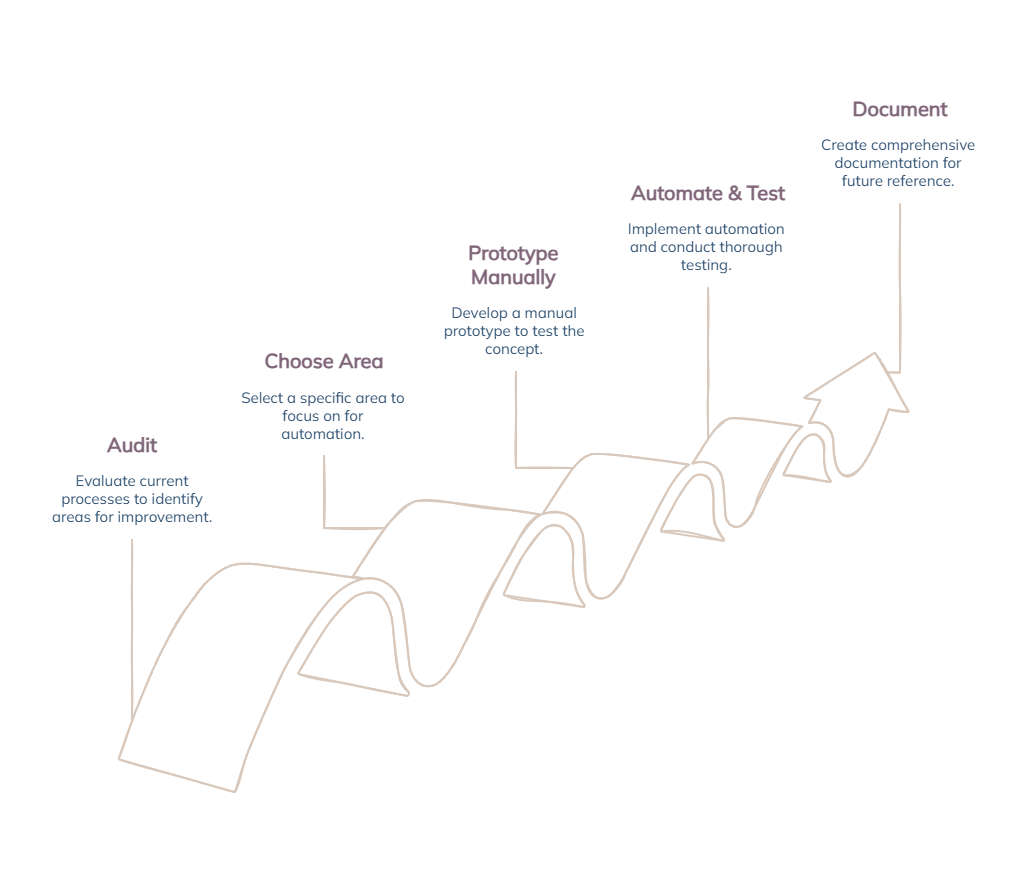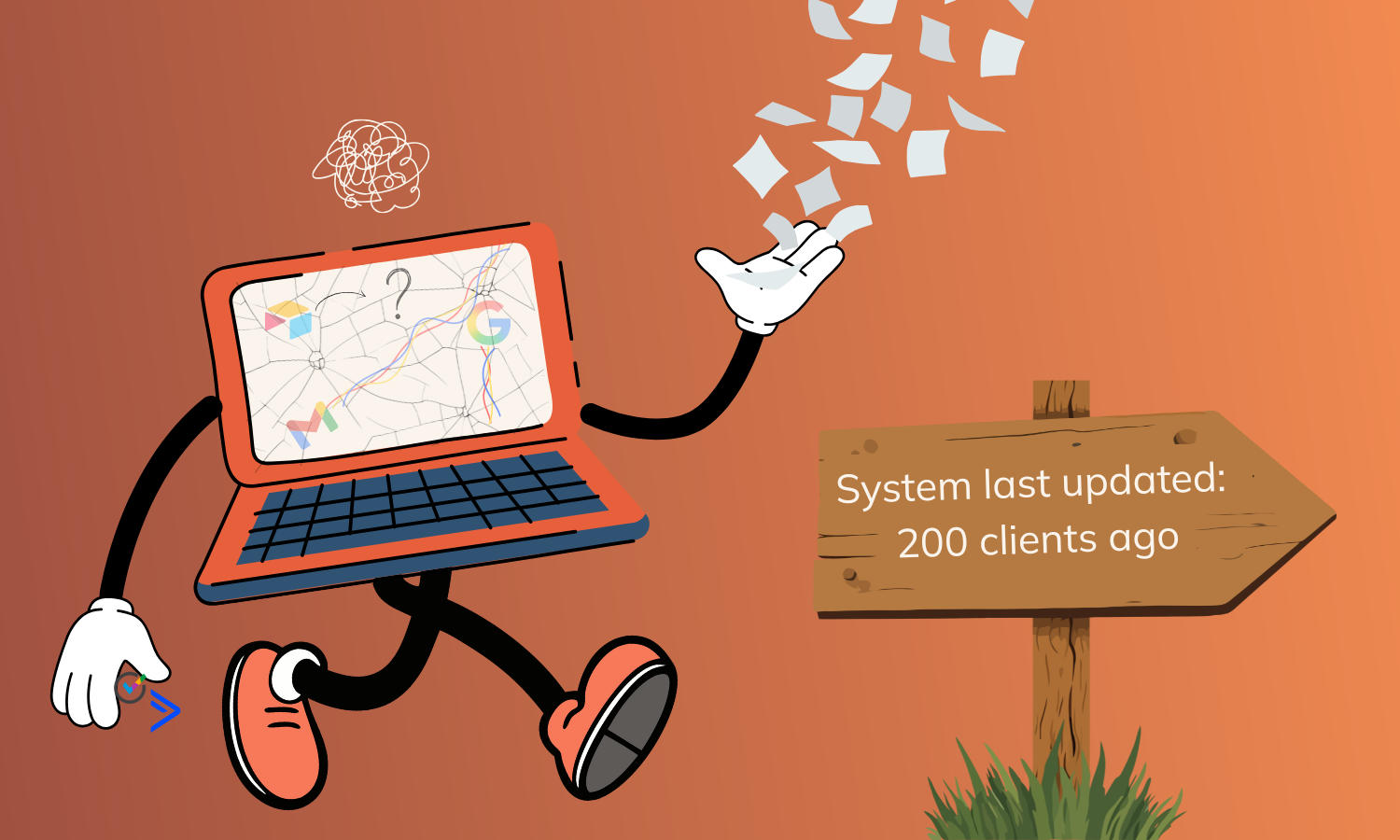.png)
Business automation can seem overwhelming, but it follows a predictable pattern. This comprehensive guide provides the exact methodology that helps business owners systematically eliminate repetitive tasks and redirect time to high-value activities.
Why most automation attempts fail
Before diving into the roadmap, it's crucial to understand why many automation projects fail:
Starting too big: Attempting to automate entire business processes simultaneously creates complexity that's impossible to troubleshoot.
Skipping the foundation: Jumping straight to tools without understanding current workflows leads to automating broken processes.
Tool-first thinking: Choosing software before defining requirements results in forcing business processes into inappropriate systems.
Lack of testing: Implementing automations without thorough testing creates new problems instead of solving existing ones.
The five-step roadmap addresses each of these common pitfalls.

Step 1: Audit your current process
Successful automation begins with brutal honesty about how work currently gets done. This audit phase reveals hidden time drains and identifies the highest-impact opportunities for improvement.
Choose your focus area
Don't try to audit everything simultaneously. Select one business process that meets these criteria:
- You repeat it at least weekly
- It involves multiple steps or tools
- It currently consumes 1+ hours per week
- It causes frustration or stress
- Mistakes in this process have business consequences
Common high-impact processes include:
- Client onboarding workflows
- Proposal and contract creation
- Project kickoff procedures
- Invoice and payment management
- Lead qualification and follow-up
- Content creation and publishing
- Team communication and updates
Document every current step
Record your process exactly as you do it now, not how you think it should be done. Include:
Time investment: How long does each step actually take? Include interruptions, tool switching, and information gathering.
Tools and systems: What software, documents, or resources do you access? Note every platform, spreadsheet, or communication channel involved.
Decision points: Where do you make choices that affect the next steps? What criteria do you use for these decisions?
Pain points: Which steps feel tedious, error-prone, or frustrating? Where do you typically get stuck or delayed?
Handoffs: If others are involved, where does responsibility transfer between people? What information needs to be communicated?
Example: client onboarding audit
A business consultant discovered their client onboarding actually involved 47 individual steps across 8 different tools, consuming 6.5 hours per new client. Steps included:
- Collecting client information via email back-and-forth
- Manually entering data into CRM system
- Creating project folders with specific naming conventions
- Duplicating template documents and customizing them
- Setting up communication channels
- Scheduling kickoff meetings
- Sending welcome packages
- Creating task lists and timelines
This audit revealed that 60% of the time was spent on data entry and file organization - perfect candidates for automation.
Step 2: Choose your focus area
Within your selected process, identify the subset that offers the highest return on automation investment.
Prioritization criteria
Time savings potential: Which steps consume the most minutes per iteration?
Error reduction impact: Where do mistakes happen most frequently, and what's the cost of those errors?
Frustration factor: Which steps do you (or your team) actively dread doing?
Scalability concerns: Which steps become more time-consuming as your business grows?
Repeatability: Which steps follow identical patterns every time?
The 80/20 analysis
Often, 20% of the steps in a process consume 80% of the time. Focus your initial automation efforts on these high-impact areas.
For the client onboarding example above, three steps consumed 4 hours of the total 6.5 hours:
- Initial information gathering (1.5 hours)
- Document creation and customization (1.5 hours)
- File organization and sharing setup (1 hour)
These became the priority automation targets.
Step 3: Create your prototype
Before touching any automation tools, perfect the manual version of your process. This step prevents automating inefficient workflows.
Template development
Create standardized versions of documents, emails, and checklists you use repeatedly. Focus on:
Consistency: Use identical language, formatting, and structure each time.
Completeness: Include all necessary information and steps to avoid back-and-forth communication.
Variables identification: Mark sections that change for each client, project, or situation. Use placeholder text like [CLIENT NAME] or [PROJECT SCOPE] to identify customizable elements.
Quality control: Test templates with real scenarios to ensure they handle edge cases and variations.
Process standardization
Document the optimal sequence of steps, including:
Triggers: What initiates this process? Be specific about timing and criteria.
Dependencies: Which steps must be completed before others can begin?
Decision trees: If the process branches based on different scenarios, map out each path.
Quality checkpoints: Where should reviews or approvals happen?
Completion criteria: How do you know the process is finished successfully?
Example: proposal creation template
A marketing agency created a proposal template with these variable elements:
- [CLIENT_NAME] and [CLIENT_INDUSTRY]
- [PROJECT_SCOPE_DESCRIPTION]
- [TIMELINE_WEEKS] and [START_DATE]
- [TOTAL_INVESTMENT] and [PAYMENT_SCHEDULE]
- [TEAM_MEMBERS_ASSIGNED]
The template can include standard sections for company background, methodology, case studies, and terms that never changed. Creating new proposals goes from 3 hours of custom writing to 30 minutes of variable completion.
Step 4: Automate and test
With templates and standardized processes in place, you're ready to implement technological solutions.
Start with simple automation
Begin with the easiest technical implementations:
Forms for data collection: Replace email back-and-forth with structured forms that capture complete information upfront.
Email templates and sequences: Set up template emails that can be sent with one click, or automated sequences triggered by specific actions.
Document generation: Use tools that populate templates with form data automatically.
Basic notifications: Set up reminders for follow-ups, deadlines, or next steps.
Progressive complexity
As simple automations prove successful, add more sophisticated elements:
Conditional logic: Different responses based on form answers or client characteristics.
Multi-step workflows: Sequences that trigger multiple actions from a single input.
Integration between tools: Data flowing automatically between your CRM, project management, and communication systems.
Advanced scheduling: Complex calendar management and resource allocation.
Testing protocols
Never implement automation without thorough testing:
Fake data runs: Test every scenario with dummy information before using real client data.
Edge case testing: What happens if someone provides incomplete information or selects unusual options?
Failure mode analysis: When something breaks, how will you know? How will you fix it?
User experience review: Is the automated process better for your clients and team, not just more efficient for you?
Real-world testing results
The business consultant mentioned earlier implemented automation for their client onboarding process:
Before automation: 6.5 hours per client, 3-5 email exchanges, occasional missed steps or information.
After automation: 45 minutes of actual work per client, complete information captured upfront, zero missed steps, professional client experience.
Result: 5+ hours saved per client, redirected to strategic consulting work that generated additional revenue opportunities.
Step 5: Document the process
Once your automation works reliably, comprehensive documentation protects your investment and enables others to manage the system.
Documentation components
Process overview: High-level explanation of what the automation accomplishes and why it exists.
Technical setup: Step-by-step instructions for rebuilding the automation if necessary, including account settings, integrations, and configurations.
Troubleshooting guide: Common problems and their solutions, contact information for technical support, and escalation procedures.
Update procedures: How to modify templates, add new options, or adjust workflows as business needs evolve.
Training materials: Instructions for team members who will use or manage the automated system.
Documentation tools
Tango: Records your screen actions and automatically creates step-by-step guides with screenshots.
Loom/Vidyard: Video recordings that capture both screen actions and audio explanations.
Process documentation templates: Standardized formats that ensure consistent, complete documentation.
Version control: Systems for tracking changes and maintaining current documentation.
Measuring automation success
Set specific metrics before implementing automation to measure its impact:
Time savings metrics
Hours saved per iteration: Compare time investment before and after automation.
Weekly/monthly time savings: Calculate cumulative impact across all process iterations.
Opportunity cost recovery: What revenue-generating activities can now fill the reclaimed time?
Quality improvements
Error reduction: Fewer mistakes, missed steps, or inconsistent outputs.
Client satisfaction: Improved experience through faster, more professional processes.
Team satisfaction: Reduced frustration with repetitive tasks.
Business impact
Capacity increase: Ability to handle more clients or projects without additional staff.
Revenue growth: New business generated from time redirected to sales and delivery activities.
Scalability improvement: Business growth no longer limited by administrative bottlenecks.
Common automation pitfalls to avoid
Over-automation: Not every process needs automation. Sometimes simple checklists or templates provide sufficient improvement.
Under-testing: Insufficient testing creates new problems instead of solving existing ones.
Tool complexity: Choosing overly sophisticated tools that require extensive setup and maintenance.
Lack of flexibility: Automations that can't adapt to business changes become obstacles rather than assets.
Documentation neglect: Undocumented automations become liabilities when they break or need updates.
Your automation roadmap timeline
Week 1-2: Complete process audit and prioritization
Week 3-4: Create templates and standardized procedures
Week 5-6: Implement basic automation and test thoroughly
Week 7-8: Document processes and train team members
Week 9+: Monitor performance and plan next automation project
The compound effect of systematic automation
Each automated process creates capacity for additional improvements. Business owners often find that their first successful automation project generates enthusiasm and confidence for tackling larger challenges.
The key is starting small, proving value, and building systematically. One hour saved per day compounds to 250+ hours annually - equivalent to more than six full work weeks redirected to your zone of genius.
Focus on progress, not perfection. A simple automation that saves 30 minutes weekly is more valuable than a complex system that never gets fully implemented.
Begin with one process, master the methodology, then systematically reclaim your time for the work that only you can do.























